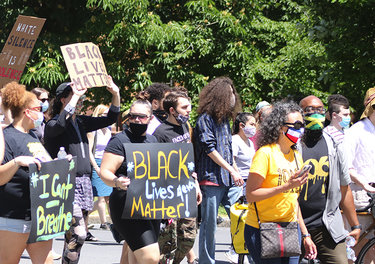Protesters can receive COVID-19 diagnostic tests.
ALBANY COUNTY — The Capital Region is on track to begin phase 2 of reopening on June 3.
Governor Andrew Cuomo said in his Monday press briefing, “The Capital District region is moving to go into Phase 2 on Wednesday. Again, all the numbers look good there. We’re going to run them by our global team to make sure they are as good as we think they are. But at this point, the Capital Region is also on track to go into Phase 2 on Wednesday.”
Western New York on Tuesday is expected to join five other regions in Phase 2, the governor said. All 10 regions of the state, except for New York city, the epicenter of the pandemic, have begun reopening.
“We went from a really internationally terrible situation to where we’re talking about reopening today,” said Cuomo on Monday. “Even New York City, where we’re planning to reopen June 8th.”
Cuomo’s remarks echoed those made by Albany County Executive Daniel McCoy at his Monday morning press briefing.
McCoy said at the control-room meeting that morning he had been hoping for the green light but instead the state officials who talk daily in a group with representatives of the Capital Region’s eight counties, discussed new metrics and a medical form they put out with doctors guiding the governor, McCoy said.
“Our numbers are still going in the right direction,” he said.
McCoy advised businesses to “be ready” and said of the governor, “If he gives us the green light, we’ll be ready to rock and roll.”
The Capital Region started the first of four phases almost two weeks ago. Phase 2 accounts for the majority of jobs in Albany County including office-based businesses, real-estate services, barber shops and hair salons by appointment, and retail outlets among others.
McCoy expressed concern that large gatherings, first over Memorial Day weekend and then with the recent protests for social justice, could spread the coronavirus and set back the county’s progress.
Albany County Health Commissioner Elizabeth Whalen said, “Any time at a mass gathering, you’d be worried about exposure.” People in the peaceful protests on Saturday afternoon “by and large” appeared to be wearing masks and maintaining social distance, Whalen said. The crowds on Saturday night, she said, were “more concerning.”
Whalen said she has taken initial steps to organize COVID-19 testing for the protesters. The first responders are already able to be tested as essential workers.
By reaching out to the state about testing for the protesters, Whalen said, she learned the already-in-place final criteria — if a doctor feels testing is appropriate — would qualify the protesters for testing.
“We would consider this appropriate,” said Whalen.
By the numbers
McCoy opened his Monday briefing with the announcement that another county resident has died of coronavirus disease 2019, bringing Albany County’s death toll to 112. The patient was a man in his seventies with multiple underlying conditions.
McCoy had devoted his Sunday briefing to news on the protests in Albany County and so did not report those daily tallies as usual.
As of Monday morning, Albany County has 1,737 confirmed cases of COVID-19, an increase of 37 in the last 24 hours. Also, 750 county residents are under mandatory quarantine and seven are under precautionary quarantine.
The five-day average for new daily positives is now 18.6.
So far, 4,611 Albany County residents have completed quarantine, with 1,359 of them having tested positive and recovered. That brings the county’s recovery rate up to 78.23 percent.
Twenty-five county residents are hospitalized with one in an intensive-care unit. The county’s hospitalization rate stands 1.43 percent.
As of Saturday, 24,764 residents had gotten tested with a percent positive rate of 7.5 percent. On May 24, there were about 21,704 people who had been tested, of which 8.3 percent tested positive. As of May 16, there were 17,226 people who had been tested with a percent positive rate of 9.2 percent.
So, although the number of residents being tested is increasing, the percentage of them who are positive for COVID-19 is dropping.
McCoy noted that the number of positive cases among the 20-to-29 age group, with 290 confirmed cases, is now “neck and neck” with the 50-to-59 age group with 293 cases.
People in the younger age group are likely to be asymptomatic and thereby spread the disease without knowing it. McCoy urged them to wear masks and to “think about the seniors in your life.”
Pointing to data on the county’s dashboard, Whalen noted that a disproportionate number of old people are hospitalized and die from the disease. She also again noted racial disparities with a disproportionate number of African Americans in Albany County being hospitalized and in intensive-care units.
The bulk of cases still tend to be in and around the city of Albany, Whalen said. The 12203 ZIP code in Albany and Guilderland continues to have the highest number of infections with 245 cases, followed by 12208 with 144 and then 12206 with 131.
Whalen noted that, while the county’s numbers continue on a downward slope, “We did get a little blip this morning in cases.”
She said her staff is actively doing case investigation and she may soon know more about the reasons for the blip.
McCoy concluded, “Hopefully, we get the green light for Wednesday. It’s going to be a different world out there. It doesn’t mean we go back to normal …
“It’s going to be some time before we can drop the masks. It’s going to be some time before we can tell people to stop staying six feet apart.”


